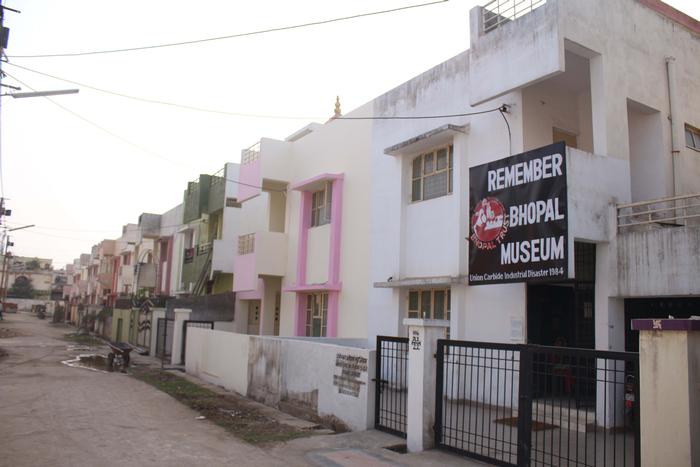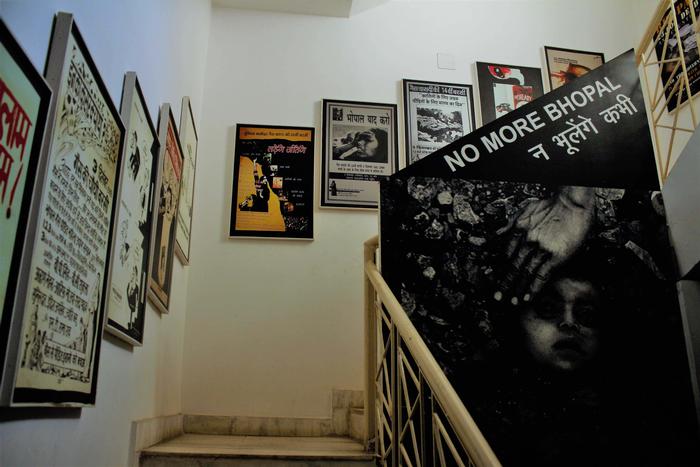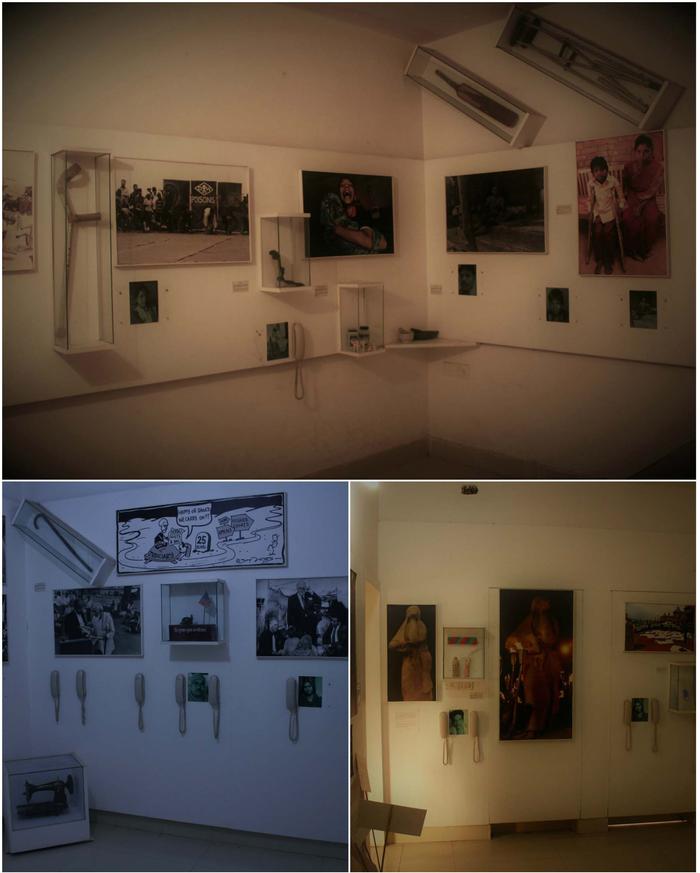Vidhi Wadhawan and Sakshi Khare EssayExpressions of Aspirations: United by a Night.“On that night, I was sleeping. Our landlord came shouting, “Sister! What is it? Who’s burning chillies?” We opened the door and there was running and shouting. “Gas has leaked! Gas has leaked! Run! Run!” I picked up my children and ran towards Berasiya Road. Our eyes were swollen and burning. The children were vomiting and suffered diarrhea. Thousands of dead bodies piled on carts were being taken to Hamidia Hospital. Corpses were buried on top of each other. There were trenches in the grave-yard. Some bodies, still alive, were buried….and dumped. So many people died in their sleep. When people broke down doors next morning, they found corpses inside. Some were identified, some not. Many Muslim corpses reached cremation grounds and many Hindu corpses reached burial grounds...” This account in Shehzadi Bi’s own voice, sends chills down one’s spine, listening to the first recording at the Remember Bhopal Museum. On the midnight of 2nd December,1984, forty-two tonnes of poisonous methyl isocyanide gas leaked from a storage tank of the Union Carbide Plant, Bhopal, exposing half a million residents. This incident is recalled as world’s deadliest manmade industrial disaster, with 8,000 immediate fatalities. A quarter million more were affected over the next three decades, of which many succumbed to death. Till date, children are being born with chronic illnesses and congenital deformities. The Bhopal Gas Kaand (incident) had silenced thousands, but the real agony was of the ones whose voices had been subdued. Battling the loss of loved ones, the survivors were left with a number of challenges: compromised health, medical expenses, diminished earning capacity, unemployment and everlasting fear of passing diseases to their progeny. The struggle was multi-fold, demanding attention in medical, educational and social spheres. The tragedy is an example of how an event can translate into a community overnight, their common bond being circumstance, not choice. Every survivor was ripped off of their ethnic, economic and occupational character, leaving them with the vestigial identity of Gas Peedit (Affected). -Without dignity, identity is erased. In its absence, men are defined not by themselves, but by the circumstances in which they are forced to live- (Hillenbrand, 2010). However, the imposed label did not remain quiescent, but evolved into an interdependent community with survivors looking out for each other, collaborating for the struggle that lay ahead. The UCIL (United Carbide India Limited) plant lies abandoned with its walls bearing slogans of protests following the tragedy. The damage done had to be addressed. Medical centers like Sambhavana clinic and Bhopal Memorial Hospital aimed at curing; International Campaign for Justice in Bhopal got involved in the political struggle; and Chingaari foundation has been supporting domestic empowerment. Thus, buildings arose to address specific needs. Post the tragedy, industrial development in the surrounding area of Karond stagnated. Due to fear and contamination, it lay empty and land prices fell. This catalyzed the growth of an ad-hoc settlement, predominantly of migrants that moved in from adjoining villages during the late nineties. This is evident from the low rise, half-built and unplastered structures here. Among the buildings that serve or are operated by the survivors, Remember Bhopal Museum is a platform for their expression to the world. This museum which acts as a mouthpiece for the deceased and the survivors is operated by survivor groups through a trust, standing as a witness to the unrecorded battle that continues. -Rather than commercially and politically manipulated knowledge, raw narratives give perspectives of victims, volunteers, and transitional governments.- The museum, instead of presenting past as a period that is over, shows how wounds remain open and bleed into the present- (Lehrer & Milton, 2011). We approached the museum through the dusty roads of Karond, flanked by the Vidhwa (Widow) Colony and Gas Colony, just two kilometers from the UCIL factory. On entering the HIG housing block, the museum’s inconspicuous setting seems confusing. Only a black billboard over the first floor parapet distinguishes it from the adjoining houses. The inside of the museum’s compound walls are painted with slogans in black and white, reminding us of the boundary walls of the UCIL factory. Slogans like “Bhopal No More” remind how Bhopal is associated with the disaster and acts as a lesson. A red paper machete bottle, reaching the parking space ceiling, painted with slogans against UCIL, replicates the tank that leaked the gas, giving an indication of what lies ahead. Safreen Khan, the caretaker sits at the reception. She is a second generation gas survivor and leads the “Children Against DOW Carbide” organization. The door behind the reception leads to the ‘Black Room’ exhibiting powerful photographs of the fateful night and its immediate aftermath. The black walls with a framework of steel pipes hanging from the ceiling replicate the ones at the plant, creating a sense of entrapment. The ceiling displaying photographs of the deceased, donated by their loved ones, confined behind the pipes, separated from those of the morning after, conveys the eternal dilemma of their departure. “It was designed to re-create the claustrophobia people felt that night. It talks of the occurrences of that night and deep personal loss. Vivek insisted the room be painted black, because it was the middle of the night and there was no escape. The pictures were also black and white, so the colour seemed perfect.” said Rama Lakshmi, the chief curator (Nath, 2014). Vivek Seth, the museum designer suggested use of landline telephones to convey oral recollections as the museum relies on verbal narrations. . Every photograph or object like a sweater, a pen, or a child’s stationary, belonging to those who passed away is accompanied by accounts of loved ones who donated it, attempting to immortalize it. Contiguity of delicate belongings, associated with life and innocence, to morbid articles, generates distress in the onlooker’s mind. Baby Naved’s sweater placed next to a chisel and hammer in the Black Room used to open up skulls, perplexes one at the extent of the horror. The objects induce nostalgia of a parallel reality that could have existed, had the holocaust not touched these individuals. The black room opens into a buffer space with a staircase to the left. Its white walls and double heighted volume offer visual relief. Walls here explain the water contamination which continues to affect the area. From the railing of the staircase, hangs a poster displaying Raghu Rai’s photograph of a child’s corpse unearthed the morning after, which evolved into a symbol of the tragedy due to its moving nature. Across the buffer space is a room displaying graphic images and belongings of children suffering from congenital deformities due to the poisonous gas. Objects ranging from dolls to inhalers accompanied by pictures and oral accounts show pain seeping in the bloods of generations to come. The cricket bat and the crutches used by Sachin, before and after the tragedy, highlight how aspirations changed overnight. As one moves to the next floor, focus shifts from what had happened to what had been done. Campaign posters on the wall along the staircase demonstrate the three decade long struggle of survivors and activists. The staircase leads to a lobby where a television screen plays footages of atrocities being meted out since 1984. A toxicity map of India shows the areas environmentally compromised by multinational corporations. The lobby is attached to two rooms facing each other. The one on the right houses memorabilia of hardships borne by those fighting for justice. Articles like shrouds, broken bangles and torches showcased here, signify the extent of intense demonstrations and their repercussions. The room on the left, through its satirical posters and installations compares the compensation given in Bhopal with that in developed nations highlights the degree of political manipulations and corruption. Although recollections and photographs comprise the primary exhibits, facts required to understand the circumstances are placed in corners of each room on banner like placards, symbolising the ongoing struggle. The programmatic reappropriation of the residence to a museum, adds to the curatorial effect of a masked reality. Fenestrations have been carefully concealed to allow space for display, while leaving traces of what may have been there originally. This suggests how the building would have been a functional household, had the tragedy not occurred and assigned it a different purpose. Absence of natural light creates a cold and somber backdrop for the grave issues addressed. The elevational quality has been left intact to blend with the context. The concentration of interventions in the internal spaces of the museum has led to an emotionally moving curatorial gesture clearly representing the community described. Most visitors aware of the tragedy find themselves at a loss of a single source of information. At the museum, individuals are offered unaltered stories that make one feel like a part of a collective memory along with the originally affected without the survivors having to tell them over. -One appeals to memory only to answer questions which others have asked us or could have asked us, placing ourselves in their perspective - (Halbwachs 1992). At the museum, distinct oral recollections form the larger collective memory, while bound by a common underlying emotion. As seen in the Black Room, the varying personal accounts of survivors, workers, doctors, lawyers and activists contribute to the final image of the night while maintaining the similar sentiment of fear and chaos. -Nostalgia remains an intermediary between collective and individual memory. Collective memory can be seen as a compendium of multiple individual recollections- (Boym, 2001). Most museums display the final collective emotion or verdict of the past, depending upon evidential information submitted by authorities. The Jim Crow Museum of Racist Memorabilia, on the contrary, depends on individual memories to produce a flexible nostalgia. Personal belongings and memoirs trace the collective memory of grotesque century long phenomenon. Similarly, Remember Bhopal Museum is a collection of independent narrations bound by the incident, rather than a singular idea. Bano Bi’s sari which she never wore, gifted by her husband- few hours before the gas leak killed him, and the torch which plays a key part at the survivors’ anniversary march every year, trigger very distinct emotions. Thus, the museum enables the viewers to perceive the information uniquely. “In 2004, on the 20th anniversary of Bhopal gas tragedy, survivor groups went around collecting objects and artefacts of victims. They set aside a room at their campaign office and placed the objects on a table in a triangular form next to each other. They called this Yaad-e-Hadsa (The Memory of Disaster) Museum”, recalled Rama Lakshmi. (Nath, 2014) The aim of this project was to act as a warning to other environmentally vulnerable communities. The idea of an independent museum was conceived by Rama Lakshmi and Shalini Sharma in 2010. Through sustained efforts of a trust comprising survivors and activists; it took form of the Remember Bhopal Museum in 2014. The government had proposed a memorial at the UCIL plant site. This suggestion caused unanimous discontent among survivors, because the use of the site prior to decontamination is deemed unethical and activists maintain that the UCIL plant must be preserved as evidence of the disaster. Hajira Bi, a survivor-activist reaffirms, “We want the factory structure repaired and preserved. It should be safe and stand erect. No government should dismantle this structure. This is our history. Our future generations, if they survive, and other people would remember through this that due to a foreign multinational a huge disaster happened in Bhopal, in 1984. A ‘Yaad-e-Hadsa’ like museum should be set up here, which should tell our memories” (Lakshmi & Sharma, 2014, p.28). The plant preserves the memory of what caused the disaster while the museum records what ensued. Survivors say the museum is an example to the Government of what a memorial should represent. In a state operated framework, representation of the three decade long movement as an integral part of the memory-structure might be lost. Collaboration among survivors, activists and designers ensures that no information remains unrepresented as may have been in case of outsourced curation. Thus, the right of memory is retained solely in the hands of survivors. “Cab drivers across Bhopal recommend the museum to tourists who wish to know about the Kaand.” informs Tasneem Khan, the museum manager. Until now the museum was only a major attraction among outstation visitors and global tourists, but is now gaining recognition as a local landmark, acting as a medium between survivor activists and those unaware of recent developments. Recognizing the underlying theme of tracing people’s lives post trauma, a delegation from the Japan Foundation found the museum most appropriate for launching of the book Sagashiteimasu, translated as “Mein dhoond raha hoon” (I’m still searching), based on the Hiroshima bombings, on its anniversary in 2016. To serve its global demographic, narratives in the survivors’ original voices, mostly in Hindi, have been provided with recorded translations in English. The museum plans on incorporating agonizing stories of victims from Hiroshima and Nagasaki bombings, and mercury contamination of Kodaikanal, Tamil Nadu. The museum accepts no donations or sanctions from the government or corporate bodies, so as to retain its autonomy and authenticity. It uses canvas instead of flex or plastic to display photographs, abstaining from use of any industrial products. In accordance to its message of minimizing usage of harmful chemicals, the museum relies on regular cleaning and herbal techniques for preserving artefacts. “Recently, a troupe of street performers came to the colony. We invited them into the museum. Their drummer stared blankly at the photograph of a woman in the black room. Within minutes, he broke down, crying. Gaining composure, he explained how it was the picture of his deceased wife, who had gone missing in the chaos ensuing the morning after the leak.” recalled Safreen. -Curation of difficult knowledge may exacerbate conflict, keeping wounds open when they might otherwise heal-(Lehrer & Milton, 2011). The incident indicates how the museum may unintentionally become an unwanted reminder to some, of their misfortune. The museum appropriately commemorates stories of the survivors’ struggle. However, goodwill attempts by the government and other external organizations should be given due credit in its expansion proposals. Achievements and progress in the struggle for justice and rehabilitation may be further highlighted to instill optimism among visitors and survivors. After our first visit, we found ourselves with renewed ability to contemplate and empathize. What we have gained reflects in our changed perspective towards the idea of community. In today’s Bhopal, three out of every eight people have been affected by the disaster directly or indirectly. Members of this latent community are diffused among us, but hold within themselves, a story of pain, betrayal, courage and acceptance. The Remember Bhopal Museum, as a true embodiment of their identity, stands inconspicuously, narrating its tale to anyone who peeks inside. It is the memory bank which acts as a driving force for the community’s struggle against any future man-made catastrophes. Rashida Bi, a survivor upholds, “A true memorial is one which lets us tell our stories of anger, bitterness, tears, and courage. Our story and our movement is a lesson for others. That’s all we are now –A lesson.”(Lakshmi & Sharma, 2014, p.28) REFERENCES Boym, S. (2001). Reflective nostalgia: Virtual reality and collective memory. The future of nostalgia .New York, NY: Basic Books. Halbwachs, M. (1992).The social frameworks of memory: On collective memory, Chicago, Illinois: The University of Chicago Press. Hillenbrand, L. (2010).A dead body breathing. Unbroken: A World War II Story of Survival, Resilience, and Redemption. New York, NY: Random House. Lakshmi, R. (2014), Personal interview, by Nath, A.A., We wanted the “Remember Bhopal Museum” to be as close as possible to the Union Carbide factory; Curator Rama Lakshmi, Saddahaq. Retrieved from https://www.saddahaq.com Lehrer, E., & Milton, C.E. (2011). Disambiguating “difficulty”. Curating difficult knowledge: Violent pasts in public places. Lehrer, E., & Milton, C.E. (2011). Questioning curation. Curating difficult knowledge: Violent pasts in public places.
Additional Help and InformationAre you in need of assistance? Please email info@berkeleyprize.org. |




